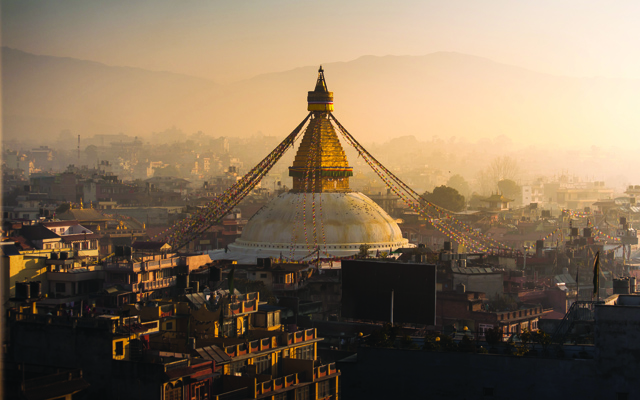Nepal tries to solidify signs of recovery by diversifying into eco- and spiritual tourism, but still faces infrastructaure and pollution issues, Marissa Carruthers reports

While 2016 arrivals were still down by 4.7 per cent compared with 2014 figures, Nepal industry members said 2017 is looking bright, with one million international arrivals anticipated.
Last year, the market showed signs of recovery, with a 39.7 per cent increase to 753,002 visiting foreigners. India was the top source market, followed by China, the US, Sri Lanka and the UK.
The devastation caused by the 7.8-magnitude earthquake that hit Nepal on April 25, 2015, saw international visitors slump from 790,118 in 2014 to 554,747 in 2015, according to figures from the Ministry of Immigration.
Despite the earthquake being restricted to 10 of the country’s 75 districts, the damage was felt nationwide. An unofficial blockade along Indian border points coupled with a fuel crisis and trade embargo hit Nepal. Overnight, the country’s tourism trade crashed.
But as the market shows signs of turning around, high hopes have been pinned on the tourism sector.
Suman Pandey, president of PATA Nepal, said: “Things are slowly starting to pick back up. Last year, we were nearly back to the figures before the earthquake and this year looks to be even better, so this is encouraging.”
The country’s recovery was severely hindered by a blanket travel warning on visiting Nepal despite many popular tourist destinations remaining untouched.
Nepal Tourism Board (NTB) CEO, Deepak Raj Joshi, said: “After the earthquake, people assumed it was the whole country. This was very damaging and we directly saw the impact it had on travel.”
Despite suffering no earthquake damage, businesses in popular Pokhara – gateway to the Himalayas – saw tourism tumble. Tejina Malla, assistant sales manager at Shangri-La Village Resort Pokhara, said: “We were not hit physically by the earthquake but we were hit very badly financially, and it’s only now starting to pick back up.”
Initiatives
Hard-hitting marketing campaigns done in major source markets in the aftermath of the disaster, to spread the word that Nepal is safe and open for business, are finally paying off. Intrepid Travel said bookings have jumped 70 per cent this year from 2016, while G Adventures, which offers ecotourism trips, reported a 62 per cent rise – surpassing its 2014 figures.
However, the industry said post-earthquake fears remain a major hurdle. Bharat Kumar Basnet, managing director of Explore Nepal, said: “People across the world thought Nepal is not a safe place to visit and we weren’t able to pass the message to the world that Kathmandu and many other places survived. People need to learn more about Nepal.”
Stepping up its game, the country hosted its first annual Himalayan Travel Mart in June, attracting 74 buyers from 36 countries and more than 50 sellers. And the industry has started to actively sell the country’s other attractions, away from the Himalayas and trekking. Huge efforts are being pumped into developing ecotourism, which is seen by many as a way to elevate the industry.
Shital Chandra Dharel of Himalaya Heart Treks and Expeditions said: “We have much more than the mountains. We have national parks, safaris, wildlife with black rhinos and tigers, more than 60 different ethnic groups, culture and a lot of adventure activities. More is being done now to promote these activities and show that Nepal really is a diverse destination.”
Spiritual tourism is another area that is being actively promoted. Nepal is home to Lumbini, the birthplace of Buddha, and other religious sites, and tour operators are starting to target South-east Asian markets such as Cambodia and Vietnam which have strong Buddhist populations and growing economies.
In June, the Bangkok-based Nepali embassy to Cambodia organised an event in Phnom Penh to promote Buddhist tourist sites and activities in Nepal. And talks about starting direct flights between the two countries began.
Not enough
But concerns have been raised that this alone won’t be enough for Nepal to reach its tourism potential. Infrastructure remains weak, airports are in desperate need of upgrading, more flight paths are essential, as is increased investment in human resources.
Saurav Rajkarnikar, executive director of KGH Hotels, which operates a string of properties in Kathmandu and Pokhara, added: “Pollution is also a big factor that needs to be addressed.”
Political stability is necessary if investment is to be put into overhauling infrastructure and upgrading roads. Nepal’s first democratic elections in 20 years is taking place this year, with the third and final stage in September.
Pushka KC, Peak’s sales manager, said: “We are happy for these elections because we need (Nepal) to be politically stable. We can promote Nepal as a leisure or spiritual destination or whatever, but if we don’t have the infrastructure to get people around, it is no good.”
To cater to the predicted increase in visitors, construction of a new US$216 million international airport in Pokhara started in June. Three kilometres east of the current domestic airport, it is slated for completion by July 2020.
In addition, Gautam Buddha Airport in Bhairahawa, gateway to Lumbini, is set to open in 2019. It is also hoped that the stalled US$92 million improvement of Tribhuvan International Airport in Kathmandu will be unveiled the same year.
While hurdles remain, the industry remains confident of the country’s potential to achieve two million foreign visitors by 2020.




















